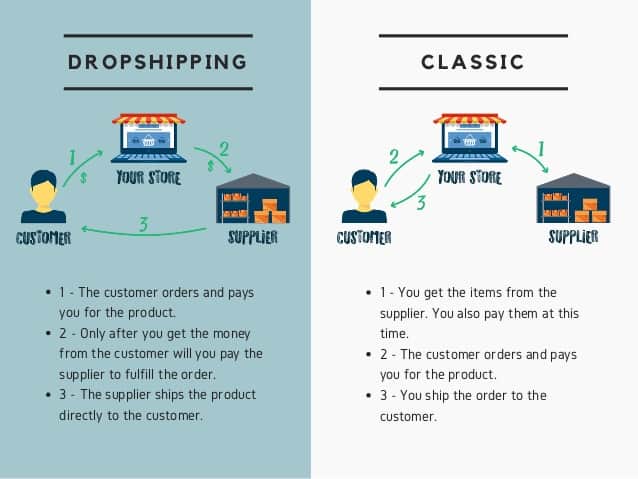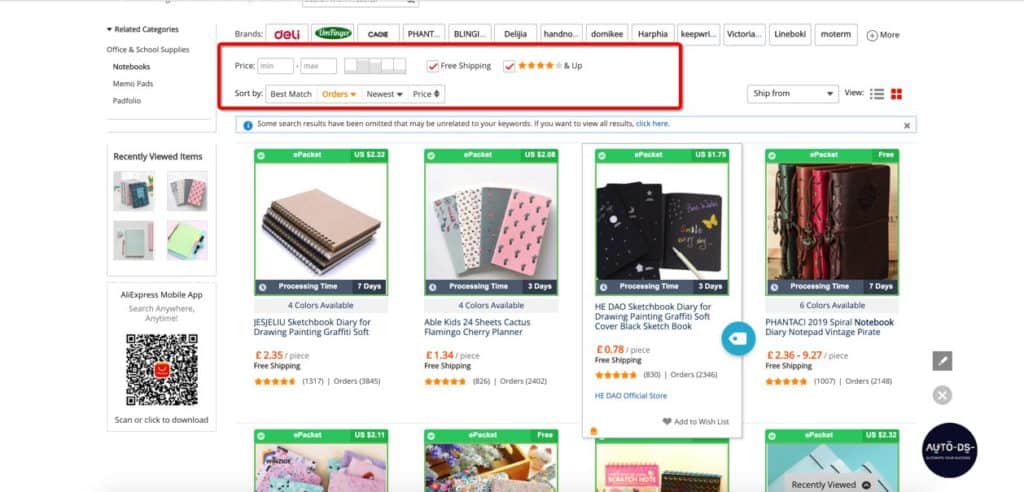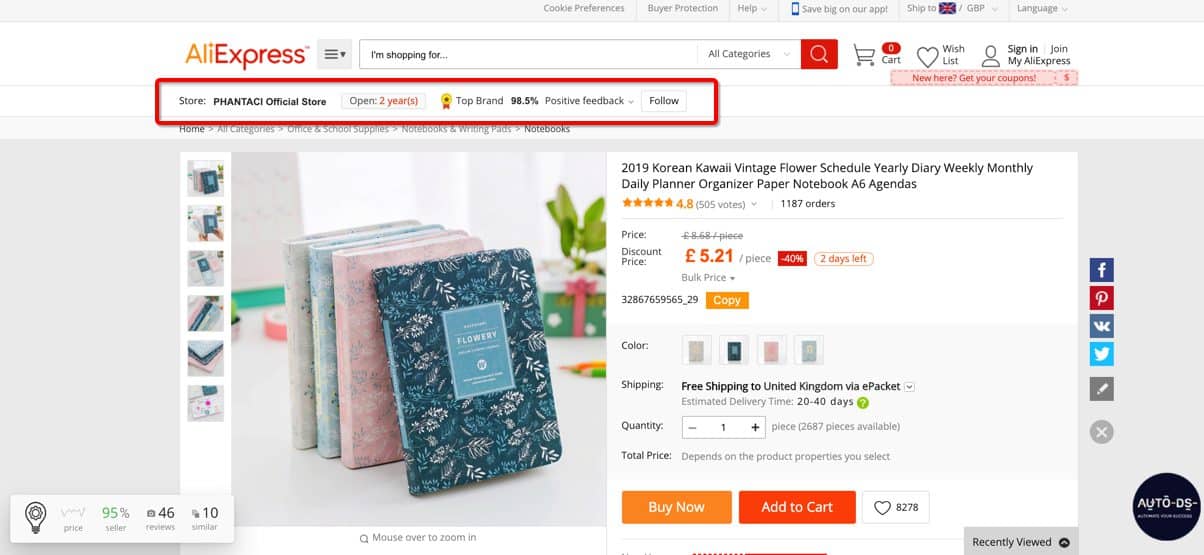If you’re an entrepreneur who wants to enter the e-commerce space but doesn’t have the resources to manage manufacturing, supply chains, and fulfillment, then dropshipping could be a great option for you.
But First…..
What is Dropshipping?
Dropshipping is a business model in which e-commerce entrepreneurs sell products without having to carry any inventory. when a store sells a product, it purchases the item from a third, who will then ship the products directly to the customer’s door. As a result, the merchant never sees or handles the product.
The biggest difference between dropshipping and the standard retail model is that the selling merchant doesn’t stock or own inventory. Instead, the merchant purchases inventory as needed from a third party that usually is a wholesaler or manufacturer that fulfill the orders.

Advantages
Low Startup Costs
It requires a lot of capital to stock a warehouse. You can eliminate the risk of going into debt to start your business by using dropshipping.
Instead of purchasing an extensive inventory and hoping that it sells, you can start a dropshipping business with zero inventory and immediately start making money.
Low Order Fulfillment Costs
Order fulfillment usually requires you to have a warehouse, organize, track, label, pick and pack, then ship your stock.
Dropshipping lets a 3rd party take care of all of that.
Your only job in this arrangement is to make sure they get your customer orders. Everything else will be handled by them.
A Faster Start-Up
There’s a lot of work in stocking inventory, finding a warehouse, taking out a lease and hiring people to manage, pick and pick your products. Without all those steps, retailers can get their businesses off the ground much more quickly.
Sell and Test More Products with Less Risk
If you know a product is doing well for another retailer or reseller, you can immediately offer it to your customers without waiting for it to arrive in your warehouse.
Dropshipping allows you to test new items without the risk of carrying obsolete inventory. Just pay for what you sell!
Flexible Location
A dropshipping business can be run from just about anywhere with an internet connection. As long as you can communicate with suppliers and customers easily, you can run and manage your business.
Disadvantages
Low-profit margins
Because of the low barriers to entry and the competitive space of online shopping, dropshipping businesses are often forced to price for very low-profit margins. It’s not until they’ve really scaled their business and built up customer loyalty that they can increase prices enough to see big financial gains.
Poorer Customer Service
If your supplier delivers products late, damages them, delivers the wrong items, or otherwise screws up your customer’s order, the customer will take it out on you.
You won’t be able to maintain the personal touch that retailers who manage their own inventory can provide customers. You won’t be able to quickly solve customer issues without overseeing the inventory yourself.
Shipping Complexities
If you work with multiple suppliers, the products on your website will be sourced through a number of different drop shippers. This complicates your shipping costs.
Let’s say a customer places an order for three items, all of which are available only from separate suppliers. You’ll incur three separate shipping charges for sending each item to the customer and automating these calculations can be difficult.
If you start a dropshipping business, make sure you work with high-quality partners.
But…There is a Solution for this Dropshipping Inventory Issue
You can use a cloud-based inventory management software like Oberlo that integrates with your supplier’s software so that both of you know how much inventory is in stock at any time.
This helps you as a drop shipper synchronize your marketing and sales campaigns with your supplier’s stock.
So, when any of your supplier’s customers make a sale (including you), it will update the amount of inventory in your supplier’s warehouse automatically.
If you want to minimize some of the issues with dropshipping and make it more worthwhile, then you need an inventory management system that tracks your stock levels in real-time.
Is Dropshipping Worth It?
Well, dropshipping isn’t a perfect, stress-free way to build a successful business.
The model has some definite advantages but comes with a number of built-in complexities and problems you’ll need to be able to address as any other business.
The good news is that with some careful planning and consideration, most of these problems can be resolved and need not prevent you from building a thriving, profitable dropshipping business.
How to Start Dropshipping?
-
Choose a Niche
A niche is a segment of a market. For example, Bluetooth speakers are a popular niche in the home audio market. You could even say that outdoor, waterproof Bluetooth speakers are a sub-niche of the Bluetooth speaker niche. You get the idea. The more specific your niche is, the better.
I recommend you go for something you are passionate about but make sure that there is a demand and potential profit to make in that market.
Also take in mind that if you choose a niche that’s already saturated with sellers or dominated by major brands, you’re going to face an uphill battle with your new business.
-
Find Good Suppliers and Product.
To find suppliers and products I recommend using Aliexpress. It has a huge amount of products and suppliers and you just have to sift through the garbage to find a gem.
Products:
Like with any other website, type in your criteria keyword and in my opinion, narrow down search results in the funnel system. To do that, follow this criterias:
- Make sure you can make at least $20 profit.
- Choose only products with a 4+ star.
- Make sure it has a sales history.
- Free shipping with ePacket.
- Make sure you can create good images with it.

Supplier:
After you have chosen a product that meets your needs, you start looking for the best dropshipping supplier by examining the store information and obtain helpful information, such as:
- Find stores between 2 to 5 years old.
- Top Brand Status. This means it has a good standard.
- Good Feedback score.

-
Start You Store with Shopify
Starting a dropshipping store is surprisingly simple. Thanks to solutions like Shopify it only takes a day or two to create a website, source products, and sell them to the world.
While there are several e-commerce solutions out there that can power your dropshipping business, Shopify continues to be one of the most popular platforms for merchants. That’s because Shopify is:
- Dropshipper-friendly
- Packed with great features
- Easy to use
- You can start with a 14 days free trial
- The cheapest and most complete software in the market.
Related Post: Create Your Own Online Store in 20 minutes.
Final Words
Starting a Shopify dropshipping business is surprisingly easy, and requires very little upfront investment. Take a day or two to find a product and then create a store using Shopify platform.
As long as you follow these next few tips, you’ll have a successful eCommerce drop shipping business for years to come.
What to do next?
- Continue to update your website. Work on your SEO and create high-quality content to bring in traffic.
- Maintain your relationship with your supplier. Keep tabs on the products you’re offering and, when you’re ready, look into adding more.
- Keep up with your customer service. Answer emails and questions, and update your FAQ page (if you have one)
- Stay on top of your social media. Refine your ads, run contests, and promote like crazy.
I hope you’ve enjoyed this article and inspire you to create one? Leave a comment down below. And don’t forget to share this article with your entrepreneurial friends.

